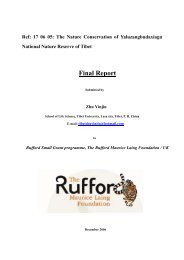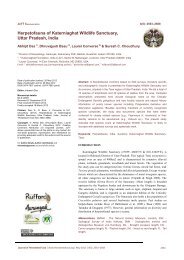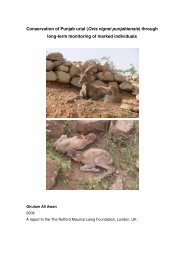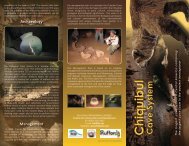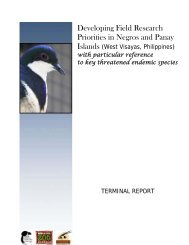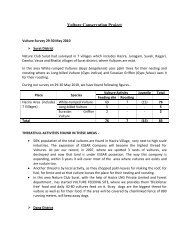Showcasing Urban Herpetofauna: A Conservational Effort through ...
Showcasing Urban Herpetofauna: A Conservational Effort through ...
Showcasing Urban Herpetofauna: A Conservational Effort through ...
You also want an ePaper? Increase the reach of your titles
YUMPU automatically turns print PDFs into web optimized ePapers that Google loves.
Scientific Findings:<br />
In this study we found 63 species of herpetofauna. Amphibians constituted of 17<br />
species belonging to 7 families and reptiles of 46 species belonging to 11 families.<br />
Among the amphibians the most commonly encountered was Duttaphrynus<br />
melanostictus, found in and around small, water bodies with or without vegetation<br />
cover. Hylarana leptoglossa was sighted in the marshes of the residential areas<br />
(Lachitnagar, Bhangagarh, Hatigaon) during the initial phase of the study. However<br />
with the filling up of these water bodies, they disappeared from the residential areas<br />
and could be encountered only in the forest areas exhibiting an extremely patchy<br />
distribution, with fewer sightings. Humerana humeralis and Hylarana leptoglossa<br />
displayed a similar distributional pattern. Microhyla ornata, Fejervarya teraiensis,<br />
Fejervarya nepalensis, Fejervarya pierrei and Polypedates leucomystax were located<br />
in patches in few of the residential localities (Lachitnagar, Lokhra, Geetanagar,<br />
Maligaon, Hatigaon). Interestingly Polypedates leucomystax was found around some<br />
of the swimming pools in the study site. Duttaphrynus melanostictus, Fejervarya<br />
syhadrensis and Euphlyctis cyanophlyctis were found to be hardy and were<br />
encountered in most of the areas including the commercial areas. Leptobrachium<br />
smithi and Clinotarsus alticola were encountered only in and around the streams in<br />
forest areas. Their tadpoles were found in aggregation in slow flowing parts of<br />
streams amidst aquatic vegetation. Hylarana tytleri was sighted moderately only in<br />
the littoral forest and among water hyacinth (Eichornia crassipes) of Deeporbeel.<br />
Amongst reptiles, the most commonly sighted lizard species was Hemidactylus<br />
frenatus. We observed five species of lizards in all the three classes of study area.<br />
However, Gekko gecko was observed only in some old trees of commercial and<br />
residential areas showing a patchy distribution in the study sites. Varanus<br />
bengalensis was extremely rare (2 sightings). Ptyctolaemus gularis, Hemidactylus<br />
garnotii, Hemidactylus platyurus, Eutropis macularia and Sphenomorphus maculatus<br />
along with a Draco species were encountered only in the forest areas. Draco sp. was<br />
encountered only once and considered as extremely rare. Hemidactylus flaviviridis<br />
was encountered only in some pockets of commercial areas (Purkayastha and Das,<br />
2009). Cnemaspis assamensis, Cyrtodactylus khasiensis and Lygosoma<br />
albopunctata are found mostly in forested areas. Though Cyrtodactylus khasiensis<br />
and Lygosoma albopunctata were occasionally seen in residential areas, Cnemaspis<br />
assamensis which is thought to be primarily a forest dwelling lizard was once<br />
encountered on the wall of a residence in Kamakhya area.<br />
11



